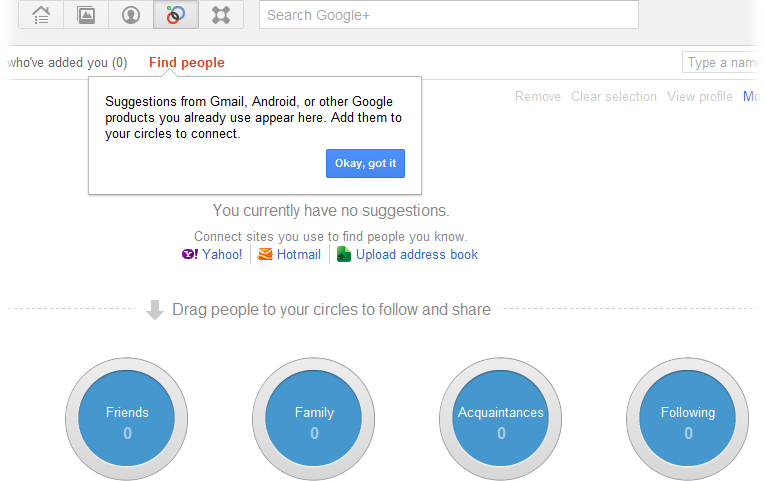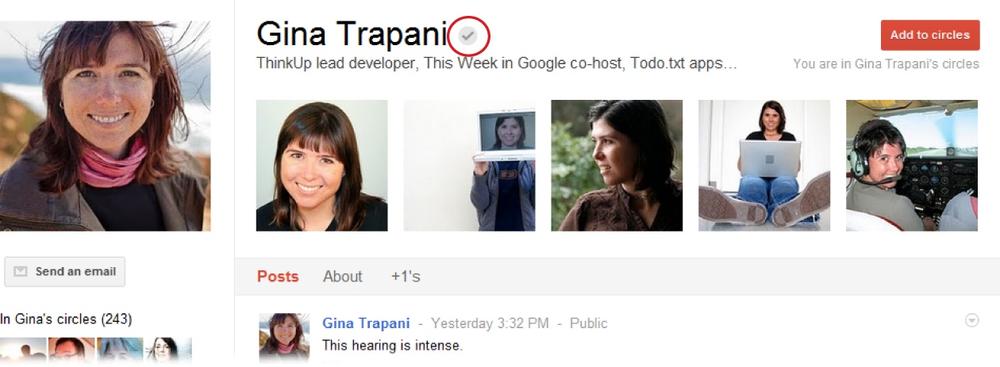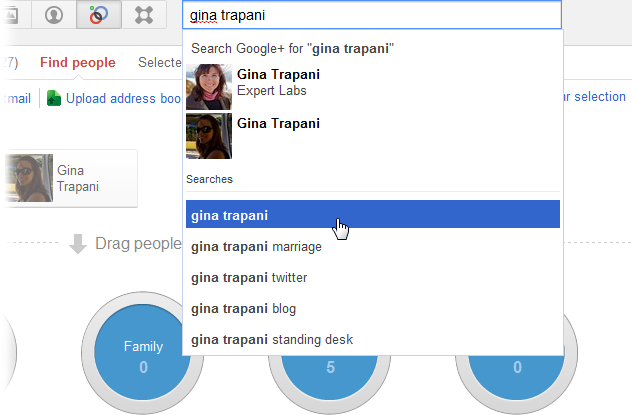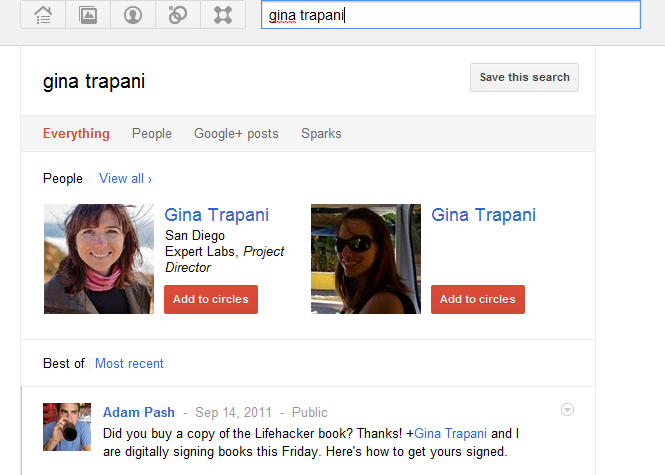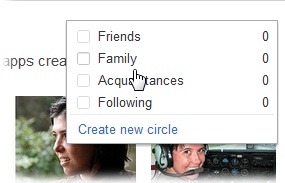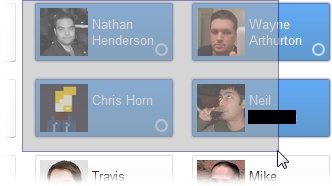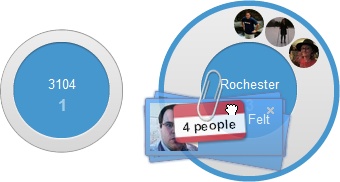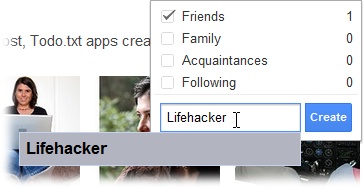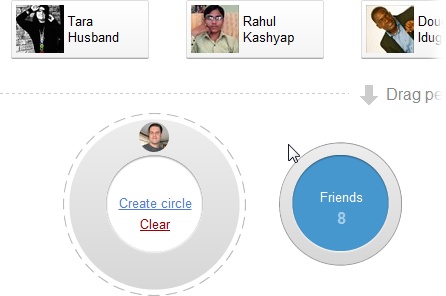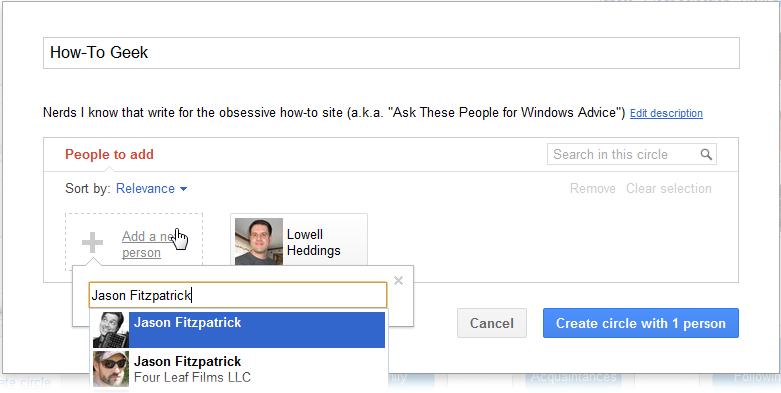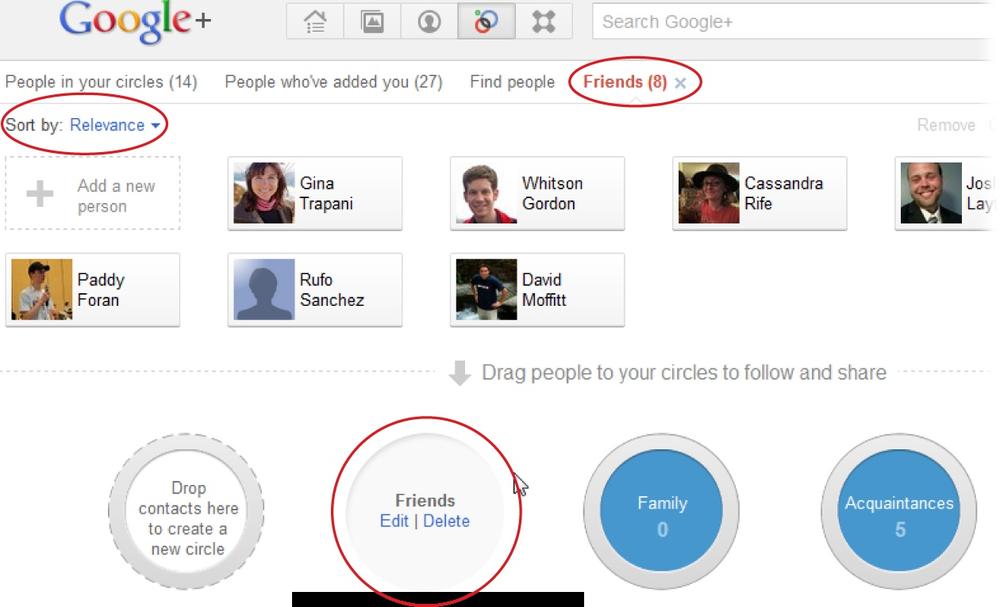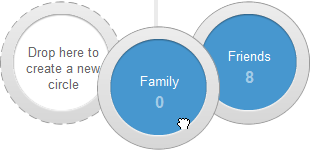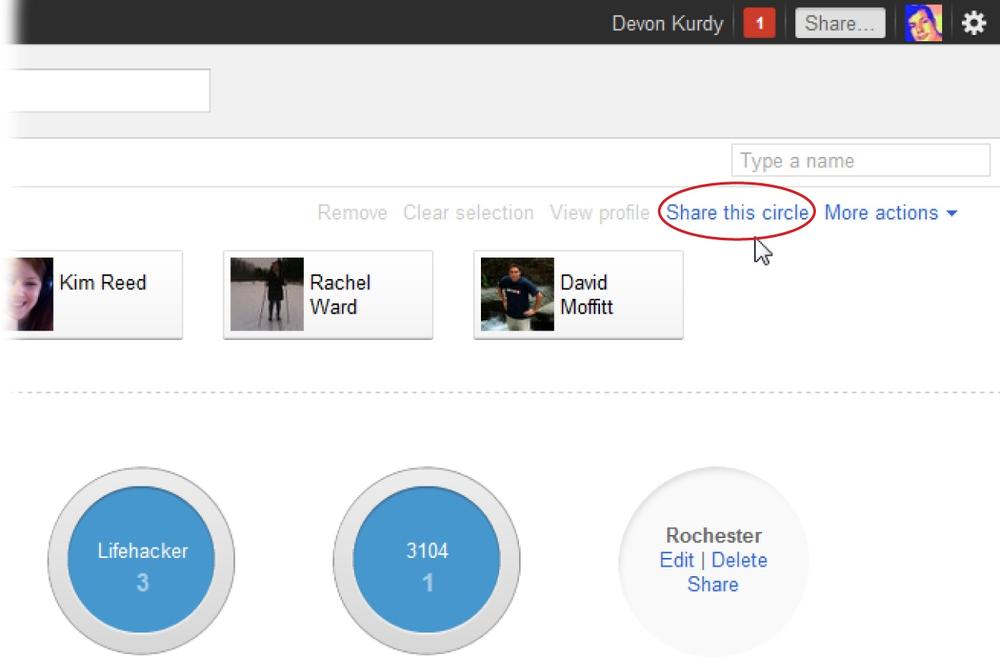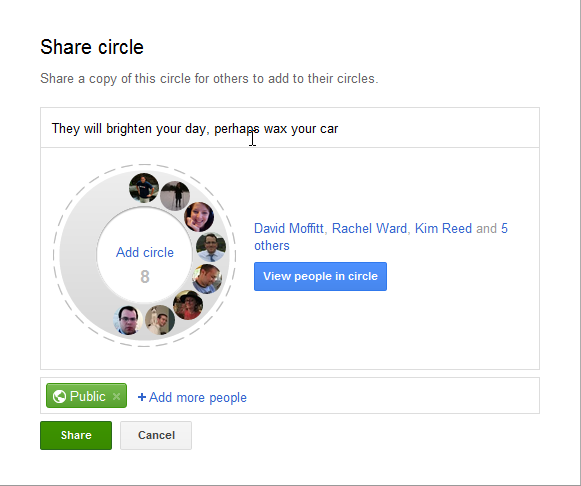Chapter 2. Managing Contacts with Circles
NOW THAT YOU’VE GOT YOUR PROFILE SET UP, you’re ready to explore circles, the heart of Google+. Circles are groups of contacts that you organize however you like. You can give your circles whatever names make sense to you, since the people in them can’t see these names. You probably already make circles in your head whenever you’re looking to make plans: the friends with young kids who probably aren’t free, the friends who don’t get along with each other, the friends who live in another city, the relatives who are loving and dear but almost certainly won’t fit in with your friends who obsess over True Blood.
Note
Other people can’t see who you put in which of your circles (unless you intentionally share a circle, as explained on Sharing Circles), but they can see the people you’re connected with on Google+—unless you hide this info. Editing Your Profile explains how.
Circles let you easily share info with folks who actually care about it, and let you restrict sensitive tidbits to just a trusted few. For example, when you’re dying to tell the world about the amazing new coffee blend you discovered at your local roaster, you can write a post about it and then share that post only with your Foodies and Friends circles, knowing that coworkers in the Better Future Corp. circle look down on such frivolity. Likewise, you can be sure when you’re looking through posts by people in your Friends circle that you won’t see any research summaries on cybernetic limb enhancement, and that many a cute nephew pic awaits you in your Family circle. You can let your Best Friends circle see all the photos from your Silly Pantsapalooza ’11 weekend, while giving your Book Club circle a peek at just one (notably cropped) shot of you sitting by the campfire.
You don’t have to create circles to use Google+. You could post updates and photos using the Public setting (explained on Writing a post while viewing your main stream), making them visible to anyone who’s added you to their own Google+ circles and anyone on the Web who has sought you out. Or you could selectively share certain things with certain people, typing out their names and cherry-picking them for each update (Other posting tips explains how to do this). But circles help make sense of who can see your profile, posts, and photos. In effect, circles create multiple versions of your Google+ account—the Friends version, the Grandchildren version, the Design School version, and so on—that you customize for each group with your custom-grouped circles And maybe the best part of circles is that nobody sees them except you—so feel free to create a Never Really Liked circle for folks you only grudgingly interact with. This chapter explains everything you need to know about creating and managing circles.
How Circles Work
WHEN YOU FIRST JOIN Google+, the site provides you with four circles that you can use if you want. (If you don’t like Google+’s circle suggestions, you can ignore, delete, or rename them.) To see these suggestions, head to your Circles page by clicking the Circles icon at the top of any Google+ page.
Google’s suggested circles give you an idea of how you might organize the people you’re connecting to on Google+. You can point to each circle to see a description of it. Here’s how you might want to use each one:
Friends. This circle is a good start, but you’ll likely want to create separate circles for close friends who know all your deep dark secrets and for friends you know from very specific contexts.
Family. Again, this circle may be a bit too all-encompassing, since not all family members fit into one big container, let alone at one Thanksgiving table. For example, you may want separate circles for your siblings and for your in-laws.
Acquaintances. You may not find this circle very useful. Why? Because, acquaintances aren’t as close as friends, so if you post something that you want to share with everyone, you may as well just make it visible to everyone on the Web.
Following. Google+ suggests using this circle in a way similar to the Follow feature on Twitter. You can add people to this circle so you can see their posts, even if you’ve never met those folks personally. (Think celebrities and politicians.) But in contrast to Twitter, where you can see every tweet posted by the people you’re following, on Google+ you only see these people’s public posts (unless they’ve added you to one of their circles and are sharing with that circle).
Note
There is a way for people in your Following circle to see what you post (Other posting tips has the details). But it’s unlikely that popular figures you add to this circle will see your posts, or even that you’ve added them to a circle, so it’s pretty safe to assume that this circle is a one-way street: You can see public posts by people in this circle, but they likely won’t ever read stuff written by little ol’ you.
Why not just put a few relatives in the Family circle, dump everybody else into Friends, and move on? You could do that, but you’d miss out on the advantages of sorting folks into circles. The following section explains more about how circles work; after reading it, you’ll likely understand the allure of circles.
Deciding Who to Share With
You have multiple interests, certain views that don’t conform to what people might expect, and people you know through particular interests or activities.Similarly, you’re probably not interested in everything your friends are interested in. For example, you and your buddy from the softball team might have remarkably compatible views on 80’s synth-pop and the best sushi in Brooklyn, but your politics might not align in the slightest. This doesn’t come up in face-to-face meetings, because you’ve both learned each other’s boundaries. But if you started a newsletter or blog that you filled with all your current political opinions and sent it out to friends like this, it would probably put an uncomfortable chill on your relationships.
This gets at the heart of what circles are meant to do. When you want to share something—a photo, a link to a web page, a “check-in” showing where you are,or just a quick note—circles make it easy to share it with exactly the right people. For example, you could upload photo 3,437 of your newborn and share it with your Family circle, the Friends With Kids circle you created to solicit parenting advice, and maybe even your Sorority Sisters circle for some bragging rights. The people in those circles will see your bundle of joy—but the folks in your Coworkers, Indianapolis, and Neighbors circles won’t.
When you view your Google+ Home page (click the Google+ logo at the top of the screen to hop there), you get the other side of the coin: You see posts written by the people in your circles that they’ve shared either publicly or with a circle they put you in. So what do you do with that one friend who’s kinda funny but who constantly complains about “tragedies” like high-end fashion boutiques not having the exact handbag she’s looking for? You have two options: You can view only posts from circles you’ve created for more curated posts and less conspicuous consumption, or you can add her to a circle named something like Blabbers, and then only visit that circle when you feel like expanding your angst horizons. (Chapter 3 explains how to view posts from specific circles.)
Circles also let you have focused conversations with a select group of people. Creating a circle like “Race for the Cure Marketing Team,” makes it easy to send links, updates, and photos to your team, and even have group text-messaging or video-chat sessions with them, without letting anybody in on the conversation who doesn’t need to be there.
Perhaps the most important thing to know about circles is that you can assign people to multiple circles. For example, you could add your buddy Steve to your Los Angeles, Church, and Coffee Snobs circles. That way, if you post something about the City of Angels, an announcement for members of your congregation, or a link to a site that sells the single-source, shade-grown Arabica you’re loving, Steve will be sure to see it.
Adding People to Circles
NOW THAT YOU KNOW how circles work, you’re probably itching to start organizing the people you know into circles. The best way to get started is to click the Circles button (pictured back on How Circles Work) at the top of whatever Google+screen you’re on.
If you’re truly new to the Google universe (you don’t use Gmail, for example) and just created your Google account as explained in Chapter 1, your Circles page will look like the one here. (You can practically hear the crickets.) But if you use Yahoo’s email service, Hotmail, or a desktop email program and have a sizable contact list built up, you can import those contacts into Google+ and see if anyone you know is already on the site (the box on the next page explains how). Even if they’re not, you can still share posts and photos with them by having Google+ send them emails; Other posting tips explains how.
If you have some contacts built up in your Google account because you’ve been using Gmail, Google Chat, or some other Google service, you might see a few familiar faces on the Circles page. (If you don’t see anyone, click “Find people” near the top of the page.) These are folks who you’ve either previously contacted, or people Google thinks you might be connected to because you have a number of contacts in common.
Tip
You can whittle down the list of people in the middle of the Circles screen by clicking “People in your circles” or “People who’ve added you” in the screen’s upper left. You probably won’t see anyone if you click “People in your circles” since you’re just getting started, but you might see a few if you click “People who’ve added you,” especially if a friend invited you to join Google+. Yup, strange as it may seem, people can actually add you to their circles before you join the site.
Don’t see any names at all, or don’t see the people you want to add? No problem. In the upper right of the Circles page, click the “Type a name” box, and then start entering the name of someone you know. As you type, Google+ displays potential matches, automatically updating its suggestions with every letter you type. The most relevant names should appear near the top—people who know one of your existing contacts (if you have any), people who live near you, people who’ve worked at the same companies as you, and so on.
If you see the person you’re looking for, double-click her name to jump to her profile page just to make extra sure you’ve found the right person. (Nothing’s more embarrassing than adding someone to one of your circles and then having that person contact you to ask, “Who the heck are you?”) The information you see in the profile is limited to things that she’s set as visible to “Anyone on the web” (just as you can set the visibility of items in your own profile; see Fleshing Out Your Profile). If the profile belongs to someone you know, go ahead and click the “Add to circles” button in the upper right of her profile, and then flip to Putting People in Circles for details about how to select the circle(s) you want to put her in.
Note
On Gina’s profile, and on the profiles of other folks of note, the gray checkmark next to her name (circled here) means that Google “verified” her name, giving you and others a thumbs-up that this person is, in fact, using her real name and is the person most people know by that name. (If you hover your cursor over the checkmark, it expands to read “verified name.”) Who gets a verification badge from Google? Celebrities, public figures, and people added to an especially large number of circles. So keep an eye out for these checkmarks when you’re looking for a profile that belongs to your favorite actor, musician, or other notable person.
How does Google verify that the Dolly Parton on Google+ is really the country music legend? They’re not telling. Gina Trapani notes that Google didn’t email, call, or contact her to verify her account, so the process remains a mystery. But unless you become a celebrity, you probably won’t get verified by Google+.
If you don’t see the person you’re looking for, don’t give up just yet. In the Search Google+ box that’s at the top of every Google+ screen, type the person’s name. A drop-down list appears with “Search Google+ for X” as the first option, followed by the same profile pictures and names that showed up when you used the “Type a name” box. Below that is a section titled “Searches” that contains some suggestions of search terms that might help you find the person you’re after.
Clicking one of these phrases or the “Search Google+ for X” option makes Google+ search its entire network, not just its database of names. So if someone mentioned the person you’re looking for in a post, or they were cited in a photo, or they show up anywhere else, you might see them in these search results. If the results include the person you’re looking for, you can click her name or photo to view her profile.
Putting People in Circles
Now that you’ve found someone you want to put in one (or more) of your circles, adding that person to a circle is easy. Google+ gives you a few ways to do this, as the following sections explain.
From a profile page
If someone’s not in one of your circles yet, at the top right of his profile page you’ll see a big red “Add to circles” button, as shown here. When you point to it with your cursor, Google+ displays a list of your existing circles. (This list probably only includes the four pre-fab ones you read about on How Circles Work, but you’ll learn how to create your own on Creating Circles.) To add someone to one of these circles, just click the name of the one you want to add him to. Simple, huh?
Note
After you add someone to a circle, you may see the “What happens when you add someone to a circle?” message box. Click “Okay, got it” to dismiss the box, or click the blue Change link to adjust the setting that lets people viewing your profile to see who’s in your circles (Editing Your Profile has the details).
From the Circles page
You can also add people to circles by heading to the Circles page shown on Adding People to Circles; click the Circles button at the top of any Google+ page to get there. If there are a bunch of boxes in the middle of the screen with people’s names (and maybe photos) on them, you can add one of those people to an existing circle simply by dragging his box onto one of the blue circles at the bottom of the page. (The circle expands so you can tell that it’s selected and, if there are any people already in it, you see their profile pictures around the edge.) Let go of your mouse button to add him to that circle.
Tip
Before adding someone to a circle, it doesn’t hurt to double-click his name box to view his profile just to make extra sure you know him.
See a bunch of people you want to add to the same circle? Click one person’s name box, and then simply click another, and another, and so on. Each box you click turns blue to indicate that it’s selected.
Another way to select multiple people is to click somewhere between the boxes in the middle of the Circles page and then drag to create a selection box, as shown to the left of this sentence. Keep holding your mouse button until the box contains everyone you want to add to a circle. When you let go, Google+ selects all the people within the selection box. (Chances are that a few people you don’t want to include will get caught up in the selection box. No problem: Just click the boxes of anyone you don’t want to add to the circle to deselect those people.)
Tip
To double-check who’s included in the currently selected batch of people, click the Selected header near the top of the Circles page. It’s smart to do this just to make extra sure you haven’t accidentally included Grandma in the group of people you plan to add to your Scandanavian Death Metal Fans circle. If someone you don’t want is part of the selected group, simply click her name box to exclude her.
Once you’ve got several people selected, click one of the blue, selected boxes and drag it toward a circle. That box and all the other selected ones will collapse into a cute little paper-clipped pile of people, with the total number shown on a folder-style label. (Wouldn’t it be easy to plan movie night if people really lined up like this?) When you let go of your mouse, Google+ adds all those folks to the circle you selected.
If you don’t see anyone listed on the Circles page, type a name into the Search Google+ box at the top of the page. If the person you’re looking for appears in the drop-down list, simply drag her name from that list onto the appropriate circle at the bottom of the page.
Tip
The Search Google+ box is also handy for sorting through your contacts if you have a ton of ’em. So rather than scrolling up and down on the Circles page to find someone in the list of people boxes, just type his name in the box and, when he appears in the drop-down list below the box, drag him into a circle.
Creating Circles
IF THE FRIENDS, FAMILY, Acquaintances, and Following circles that come with Google+ don’t match the way you’d like to organize the people you know, no problem. You can create your own circles using any of these methods:
On someone’s profile page, put your cursor over the red “Add to circles” button and then click the “Create new circle” link that appears. Google+ displays a text box so you can name your new circle. Type a name and then click Create to add that person to that circle.
Note
If person whose profile page you’re viewing is already in one of your circles, you won’t see the “Add to circles” button. In its place, you’ll see a green button labeled with the name of the circle you put her in or, if she’s in more than one of your circles, the green button will say “2 circles” (or “3 circles,” or whatever). No matter what the button looks like, pointing your cursor at it will display the list shown in the previous illustration, with checkmarks next to the circles she’s in.
On the Circles page, you have two ways to create a new circle:
Drag a person’s name box onto the circle that’s labeled “Drop contacts here to create a new circle” (you can also select several name boxes and drag one of them onto the “Drop contacts here” circle to add them all in one fell swoop). That person (or those people) will orbit inside the in-progress circle until you click the “Create circle” link inside it. (If you change your mind and decide not to create the circle, or start over, click the Clear link instead.) When you click “Create circle,” you’ll see a new window pop out, where you can name the circle, give it a description (mostly so you can remember the reason for its existence), and add many more people quickly by searching them out.
Click the circle labeled “Drop contacts here to create a new circle” (it changes to display a “Create circle” link). Google+ displays a dialog box where you can type a name for the circle and a description, and add people. To add someone, click the “Add a new person” box and then start typing a name; when the person you want appears in the list of suggestions, click her name to put her in this circle. Once you’ve added everyone you want in this circle, click the “Create circle with” button, which lists the number of people you’ve added. (If you’d rather add people to this circle by dragging their boxes on the Circles page, click the “Create empty circle” button instead.)
Types of Circles to Consider
You should create whatever circles work for you. The way you use Google+ may be different from everyone else, and you may end up setting everything you post as visible to all your circles or everyone on the Web. But if you want more fine-grained control of who you share with, here are a few types of circles you could set up:
Location-based. Sometimes you really do want to tell everybody you know how great the weather is in your neck of the woods. But your friends in Baltimore probably don’t care about the awesome cupcake shop you just found in Portland, Maine. So it might make sense to create separate Baltimore and Portland circles.
Work groups, volunteer groups, and so on. If you work with people on projects, Google+ is a great way to share resources and comments—and even communicate in real time. Add the people you work with on various projects to project-specific circles to start the conversation.
Casual groups. Maybe you meet up with a small crew every day, week, or month to have coffee, try a new restaurant, or take in a movie. Wouldn’t it be nice to relive jokes, expand on ideas, or just trade gossip between sessions? Create a circle for each group to do just that.
Sensitive and tricky types. Some people just can’t resist the temptation to comment on, question, or raise a ruckus over every little thing. You don’t have to create circles like Powder Kegs, Gossips, Irritable Conservatives, or Sensitive Liberals, but if you do, the people you add to them would never know and you might save yourself some headaches. Having circles like these will prevent you from simply posting everything to all your circles, but it’s worth that inconvenience to avoid having those people post head-shaking comments.
More-specific Following circles. Rather than just adding everyone you’re interested in hearing from to the generic Following circle (How Circles Work), consider creating separate circles for your specific interests: Cooking, News, Technology, Music, and so on.
You may not need all this differentiation in your Google+ account, but circles are free and you can create as many as you want, and having a lot of them isn’t usually a bother, so you may want to try adding a few to see whether they work for you. You can always delete the ones you don’t end up using.
Editing and Organizing Circles
THE CIRCLES PAGE MAKES it easy to organize your social contacts. To get started putting everything in its place, put your cursor over a circle at the bottom of the page. When you do, the circle expands and, in the gray ring around the outside, you see the headshots of up to a dozen of the people in that circle. Next to the circle, a message box appears that lists the total number of members in that circle.
Tip
To delete someone from a circle that you’re pointing to on the Circles page, simply click the person’s headshot in the gray ring and drag their picture off the circle.
For the four circles Google provides (Friends, Family, Acquaintances, and Following), the message box also includes a description, but you don’t have to stick with it. To edit that description or do more in-depth circle editing, click anywhere in the blue center of the circle. When you do, the circle flies up to the top half of the Circles page, where you’ll see boxes for each of the people in that circle. (You can tell which circle’s members are displayed because Google+ puts the name of the circle above the boxes.)
The circle you clicked turns gray, and Edit, Delete, and Share links appear in it. Clicking Edit displays a small box, where you can change the circle’s name and description. The Delete link does just what you’d expect—deletes that circle. But deleting a circle only deletes the circle itself. You can always find the people in it again (Adding People to Circles), and those people won’t be removed from any other circles you put them in.
Near the top left of the Circles page, above all the people boxes, is a “Sort by” drop-down menu that lets you change the order in which Google+ sorts the people in this circle. Click this menu and you can choose to sort folks by first name, last name, relevance (explained in the following Note), or the order in which you added them. To find more people to add to this circle, you can use the “Type a name” box just above these contacts on the right, which instantly shows other people you might want to add to this circle below the list of folks already there, as quickly as you can type. Simply drag those name boxes that appear onto the appropriate circle, as explained on From the Circles page.
Note
How does Google+ sort your contacts by “relevance,” exactly? The folks at Google aren’t telling, but it seems to be based on whether you’ve had other interactions with those people via other Google services (you’ve traded messages in Gmail, for example, shared photos through Picasa Web Albums, or what have you). This sorting option doesn’t necessarily work too well for everyone, so try other options to sort through people and find new circle additions.
Just as on the main Circles page, you can double-click a person’s name box to see her profile, and select multiple people by clicking them in succession or drawing a box around them. Your changes are saved automatically as you move people around.
That’s how you manage the name, description, and roster of a circle, but how do you organize your circles themselves? Say you want to give a few circles priority placement when they show up in various Google+ lists and on the Circles page? You do that the same way you organize people on Google+: by dragging them around.
At the bottom of the Circles page, drag any circle in your collection to reposition it so that it’s in a higher position and easier to access when it’s time to add people or choose a group to check on. As shown here a faint gray line indicates where the circle will end up when you release your mouse.
Tip
Need some more space to figure how to arrange your circles? Put your cursor over the dotted gray line between your contacts and circles, and the cursor turns into two arrows with one or two horizontal lines between them. When you see that cursor, drag to move the divider between your contacts and your circles to provide more room for either section.
Sharing Circles
YOU’VE LEARNED ALL ABOUT creating, naming, and organizing circles, and you might never want to let people see some of your circles (like Sexist Salespeople, for instance). But maybe you’ve created a great “Chefs on Google+” circle and want to share it with all your fellow foodies. You can do that pretty easily.
At the bottom of the Circles page, click the circle you want to share so that its members are shown in boxes near the top of the page. On the right side of the page, you’ll see links for removing people, viewing profiles—and a “Share this circle” link.
When you click this link, you’ll see a box asking which of your circles you want to share this circle with (sounds like a recipe for motion sickness). You can also add a comment, which you should definitely provide so that the people you’re sharing with know why you think they should add a whole group of people they probably don’t know to a new circle.
When you click Share, you’ll be prompted to choose which other circles or people you want to share your circle members with. Note that it’s just the members of the circle you’re sharing, in a bundle—your name for the circle isn’t revealed. The people you shared the circle with will see it in their streams You’ll learn more about what people see when you share things with your circles in the next chapter.



